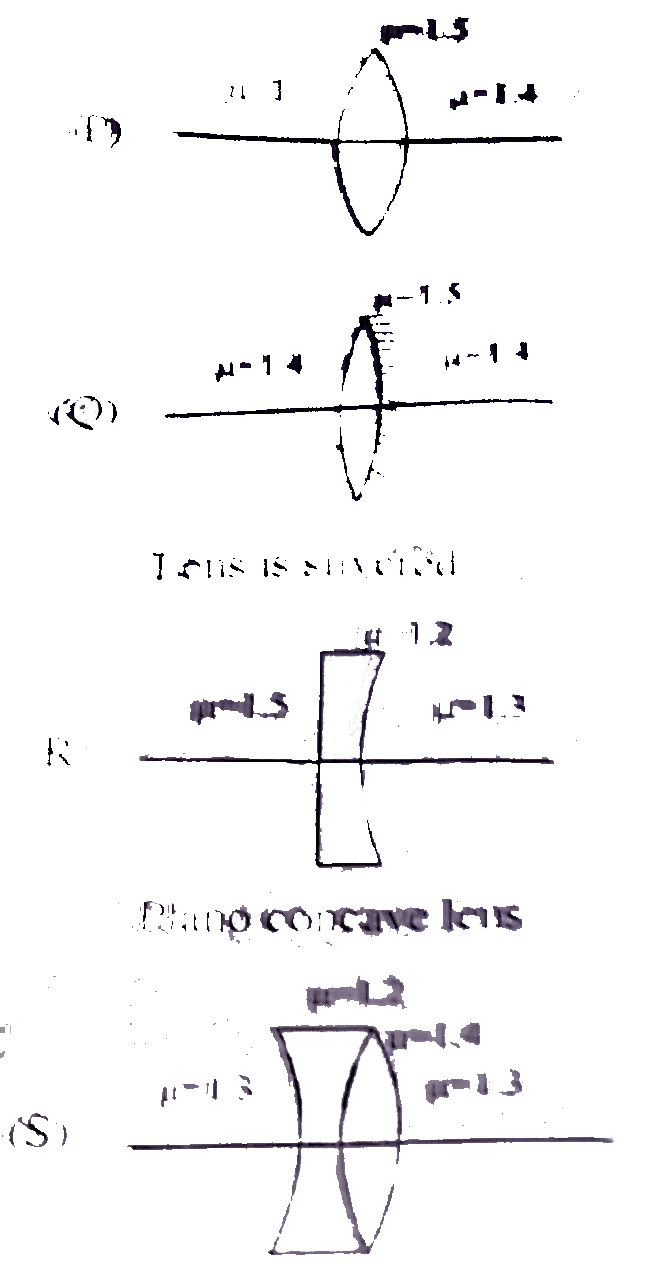A transparent thin film of uniform thickness and refractive index n1=1.4 is coated on the convex spherical surface of radius R at one end of a long solid glass cylinder of refractive index n2=1.5, as shown in the figure. Rays of light parallel to the axis of the cylinder traversing through the film from air to glass get focused at distance f1 from the film, while rays of light traversing from glass to air get focused at distance f2 from the film, Then

|f1|=3R
|f1|=2.8R
|f2|=2R
|f2|=1.4R
The correct Answer is:A, C
We can use the refraction formula for two refractions which are taking place in each case.
μ2v−μ1u=μ2−μ1R
Air to n1
1.4v1−1∞=1.4−1R …(1)
Image from this refraction will serve as object for the next refraction.
n1 to n2
1.5f1−1.4v1=1.5−1.4R ...(2)
Adding equations (1) and (2) we get the following :
1.5f1=0.4R+0.1R=0.5R
f1=3R
Let us proceed similarly for f2.
μ2v−μ1u=μ2−μ1R
n2 to n1
1.4v1−1.5∞=1.4−1.5−R ...(3)
Image from this refraction will become object for the next refraction.
n1 to air
1f2−1.4v1=1−1.4−R ...(4)
Adding equations (3) and (4) we get the following :
1f2=1.4−1.5−R+1−1.4−R
⇒ 1f2=−0.1−R+−0.4−R=0.5R
⇒ f2=2R
Hence answer (a) and (c) are correct.
Topper's Solved these Questions
- RAY OPTICS AND OPTICAL INSTRUMENTSBook:MODERN PUBLICATIONChapter:RAY OPTICS AND OPTICAL INSTRUMENTSExercise:OBJECTIVE TYPE QUESTIONS (D. MULTIPLE CHOICE QUESTIONS)
Explore 5 Videos
- RAY OPTICS AND OPTICAL INSTRUMENTSBook:MODERN PUBLICATIONChapter:RAY OPTICS AND OPTICAL INSTRUMENTSExercise:OBJECTIVE TYPE QUESTIONS (ASSERTION REASON TYPE QUESTIONS)
Explore 10 Videos
- RAY OPTICS AND OPTICAL INSTRUMENTSBook:MODERN PUBLICATIONChapter:RAY OPTICS AND OPTICAL INSTRUMENTSExercise:OBJECTIVE TYPE QUESTIONS (JEE (ADVANCED) FOR IIT ENTRANCE)
Explore 20 Videos
- NUCLEIBook:MODERN PUBLICATIONChapter:NUCLEIExercise:CHAPTER PRACTICE TEST FOR BOARD EXAMINATION
Explore 15 Videos
- SEMICONDUCTOR ELECTRONICS METERIALS DEVICES AND SIMPLE CIRCUITS Book:MODERN PUBLICATIONChapter:SEMICONDUCTOR ELECTRONICS METERIALS DEVICES AND SIMPLE CIRCUITS Exercise:CHAPTER PRACTICE TEST FOR BOARD EXAMINATION
Explore 12 Videos
Similar Questions
The refractive index of glass for light going from air to glass is 32. The refractive index for light going from glass to air will be:
View SolutionA ray of light is incident on the surface of a glass plate of refractive index 1.6 at polarzing angle. Calculate the angles of reflection and refraction.
View Solution
Knowledge Check
Rays of light get refracted while passing from air to glass
becauseAa denstiy of glass is higher than that of air.Bb they can not be reflected from a glass surface.Cc glass absorbs energy from the light rays.Dd speed of light in glass in less than the speed of light in air.List-I gives different lens configurations. The radius of curvature of each surface is R. Rays of light parallel to the axis of lens from left of lens traversing through the lens get focused at distance f from the lens. List-II gives corresponding values of magnitudes of f (mu represent refractive index):-
 APQRS1324BPQRS1234CPQRS2341DPQRS3412
APQRS1324BPQRS1234CPQRS2341DPQRS3412A double convex lens made of glass (refractive index n=1.5) has the radii of curvature of both the surfaces as 20cm. Incident light rays parallel to the axis of the lens will converge at a distance L such that
AL=20cmBL=10cmCL=40cmDL=203cm
A ray of light falls on a glass plate of refractive index μ=1.5.
What is the angle of incidence of the ray if the angle between the reflected and
refracted rays is 90∘?
View SolutionA ray of light 10−9 second to cross a glass slab of refractive index 1.5. The thickness of the slab will be
View SolutionA ray of light is incident on the surface of plate of glass of refractive index 1.5 at the polarising angle. The angle of refraction of the ray will be
View SolutionA double convex thin lens made of glass (refractive index μ=1.5) has both radii of curvature of magnitude 20 cm . Incident light rays parallel to the axis of the lens will converge at a distance L such that
View SolutionA ray of light travelling in glass (refractive index 1.52) enters water (refractive index 1.33) obliquely, The ray of light
View Solution

